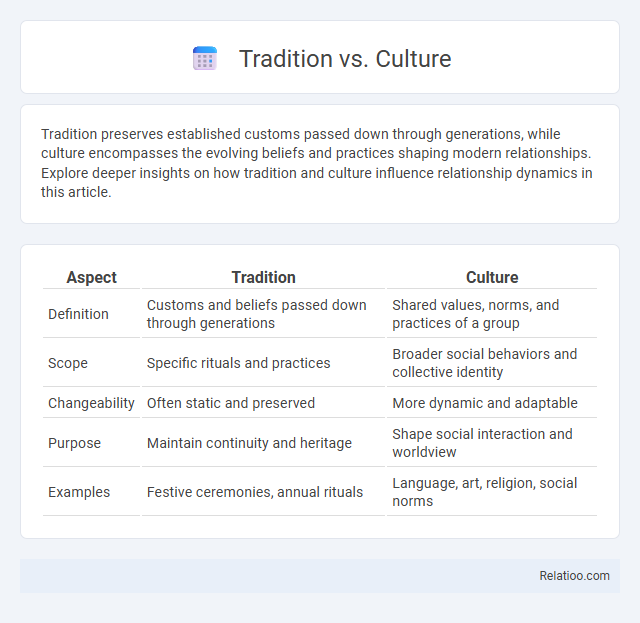Tradition preserves established customs passed down through generations, while culture encompasses the evolving beliefs and practices shaping modern relationships. Explore deeper insights on how tradition and culture influence relationship dynamics in this article.
Table of Comparison
| Aspect | Tradition | Culture |
|---|---|---|
| Definition | Customs and beliefs passed down through generations | Shared values, norms, and practices of a group |
| Scope | Specific rituals and practices | Broader social behaviors and collective identity |
| Changeability | Often static and preserved | More dynamic and adaptable |
| Purpose | Maintain continuity and heritage | Shape social interaction and worldview |
| Examples | Festive ceremonies, annual rituals | Language, art, religion, social norms |
Understanding the Concepts: What is Tradition? What is Culture?
Tradition refers to the customs, beliefs, and practices passed down through generations, forming a continuity of social behaviors within a community. Culture encompasses a broader spectrum, including language, art, values, norms, and collective identity that shape the way of life of a group. Understanding tradition as a subset of culture highlights the role of inherited rituals and established patterns in reinforcing cultural identity and social cohesion.
Origins: How Traditions and Culture Evolve
Origins of traditions and culture trace back to shared experiences and collective memory shaping community identity over generations. Traditions are specific practices passed down to preserve historical continuity, while culture encompasses broader social behaviors, beliefs, and values evolving dynamically through interaction and adaptation. Understanding your role in this ongoing evolution helps connect the past with present societal frameworks and guides future cultural expressions.
Key Differences Between Tradition and Culture
Tradition consists of customs, beliefs, and practices passed down through generations, often maintained within specific communities or families. Culture encompasses the broader social behaviors, norms, language, art, and values that define a society as a whole. While tradition is a subset of culture focused on continuity and heritage, culture represents the dynamic and evolving collective identity of a group.
The Role of Tradition in Preserving Identity
Tradition plays a crucial role in preserving identity by maintaining customs, rituals, and beliefs passed down through generations, which anchor communities to their historical roots. Culture encompasses a broader spectrum, including language, art, and social habits, evolving with time while still reflecting traditional values. Your understanding of these distinctions helps nurture a strong sense of belonging and continuity within your community.
How Culture Shapes Societies
Culture shapes societies by influencing values, beliefs, and social norms that guide behavior and interactions. Unlike tradition, which often consists of specific inherited practices, culture encompasses a broader spectrum of shared knowledge, language, and customs that evolve over time. Your understanding of cultural dynamics can help foster social cohesion and drive community development.
Interconnectedness of Tradition and Culture
Tradition and culture are deeply interconnected, with tradition representing the inherited customs and practices passed down through generations, serving as the foundation of cultural identity. Culture encompasses a broader scope, including language, beliefs, art, and social norms, all of which are shaped and sustained by ongoing traditions. This dynamic relationship ensures that traditions both reflect and reinforce culture, maintaining continuity while adapting to societal changes.
Changing Traditions in a Modern World
Changing traditions in a modern world reflect the dynamic interplay between long-established customs and evolving cultural values influenced by globalization and technological advancements. While traditions represent inherited practices passed down through generations, culture encompasses the broader social behaviors, beliefs, and norms shaping a community's identity. Adaptation of traditions often occurs as societies embrace modernity, balancing preservation with innovation to remain relevant in contemporary contexts.
Culture as a Dynamic Force
Culture acts as a dynamic force continuously evolving through social interactions, technology advancements, and globalization, distinguishing itself from tradition, which refers to static practices passed down over generations. Unlike tradition's fixed rituals, culture adapts by integrating new values, beliefs, and customs that reflect contemporary societal changes. This fluidity of culture fosters innovation and diversity, shaping collective identities in an ever-changing world.
The Impact of Globalization on Traditions and Culture
Globalization reshapes traditions and culture by blending diverse practices and values, often challenging the preservation of unique customs. Your cultural identity evolves as global influences introduce new ideas, technologies, and lifestyles, sometimes resulting in the erosion of traditional rituals or the fusion of cultural elements. The tension between maintaining heritage and embracing innovation highlights the complex impact of globalization on societal norms and cultural expressions.
Tradition vs Culture: Finding Harmony in Diversity
Tradition consists of inherited customs and rituals passed down through generations, often rooted in historical practices and community identity. Culture encompasses a broader spectrum, including language, art, beliefs, and social norms that evolve dynamically within societies. Finding harmony between tradition and culture involves respecting time-honored customs while embracing cultural diversity and innovation to foster social cohesion and mutual understanding.

Infographic: Tradition vs Culture
 relatioo.com
relatioo.com